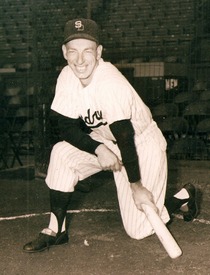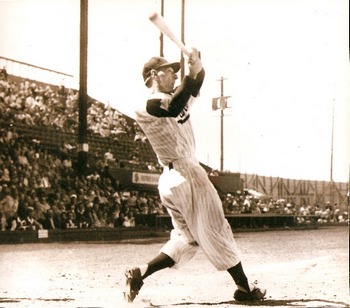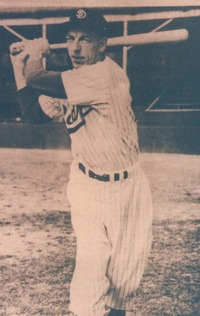

|
|
Date and Place of Birth:
May 20, 1921 Corunna, Michigan
Died:
February 13, 1992 Swedesboro, New Jersey
Baseball Experience:
Major League
Area Served:
European Theater of Operations
Rapp was originally signed by Phillies’ scout Jocko Collins in 1940
and played for the pennant-winning Ottawa-Ogdensburg Senators in the
Canadian-American League. The following year he was sent to the
Detroit Tigers’ organization and played for the Jamestown Falcons,
league champions of the PONY League.
In 1942, Rapp moved up the ladder to the Tigers’ International
League affiliation at Buffalo. However, the competition was too
stiff for the youngster and he spent the bulk of the year with the
Hagerstown Owls of the InterState League whwre he hit .284 in 137
games. For the third successive year Rapp was with a team that
reached the playoffs but tragedy almost struck on September 17.
Rapp, manager Dutch Dorman and four other Hagerstown players were
hurt when their station wagon overturned after a tire blew out. They
were returning from Wilmington, Delaware where they played a playoff
series with the runner-up in the pennant race. The accident occurred
near Lancaster, Pennsylvania and all six players suffered
lacerations and brush burns.
On September 28, 1942, Rapp entered military service with the Army
in Baltimore, Maryland. He initially served near Huntsville, Alabama
then trained with the 83rd
Chemical (Motorized) Battalion at Camp Gordon in Augusta, Georgia.
While at Camp Gordon, he continued to display his athletic abilities
in baseball, basketball, football, track, boxing and table tennis.
Late in 1943, Rapp embarked for Europe where he served 556 days as a
sergeant. In early 1945, Sergeant Rapp earned the Silver Star for
his part in the battle of the Colmar Pocket -
a
three-week battle where Allied forces overwhelmed the German
Nineteenth Army in bitter, extremely cold winter fighting over
terrain that offered practically no cover for attacking forces.
Rapp's platoon of 48 men had been cutoff near the little French town
of
Riquewihr.
The lieutenant in command ordered them to dig fox holes and lie low
until early dawn to make a break for their own lines but almost
immediately a German sniper killed the officer with a bullet through
the temple. That put Sergeant Rapp in command.
The
last GI to leave his foxhole was Rapp. No one covered him. "I never
ran so hard in my life. You never know how hard you can run until
your life is at stake. I thought that night that I'd never play
baseball again … and that's what I thought mostly about… I said
'Rapper, if you ever get through this, you'll play baseball like you
never played it … hustle … and fight every pitcher … and learn to
hit lefthanders.'” Only seven men made it back to safety.
In addition to the Silver Star,
Sergeant Rapp also earned the Purple Heart
when he was wounded in the tendons behind the knee, which would
hamper his running ability and affect his baseball career.
Rapp
returned home in November 1945. He joined Buffalo in 1946 but was
out of condition after serving in the military for three years and
in May was optioned to Detroit’s farm team in the Eastern League –
the Williamsport Grays where he hit .332 in 64 games. It didn’t take
long for Rapp to find his stride. He was recalled by Buffalo and in
August hit one of the International League's most dramatic home runs
of 1946 when he unloaded a fence-clearing shot into Woodlawn Avenue
with the bases loaded and two out in the ninth to defeat Jersey City
4-3.
The
6-foot-2 outfielder remained with Oakland in 1950, batting
.314 with 24
home runs and 145 RBIs,
and a trade to the New York Giants on July 1, 1951 marked Rapp’s
return to the major leagues. He played 13 games with the Giants
until being selected off waivers by the St Louis Browns in
September. Rapp came alive with the Browns and hit .327 in 26 games.
Despite a promising end to his 1951 season, Rapp got off to a slow
start with the Browns in 1952. He hit just .143 over 30 games and
was traded to the Senators in June. He played a career-high 46 games
with Washington and batted a respectable .284 to end his major
league career, leading the American League with 54 pinch-hit
appearances and 10 pinch-hits.
Rapp
was far from done with professional baseball, however. He was back
in the Pacific Coast League in 1953 – this time with the San Diego
Padres and remained with that club until 1957. He hit .311 in 1953
with 24 home runs and 108 RBIs; following that with a .337 average
in 1954 and another 24 homers. In 1955, he hit 30 home runs with 133
RBIs and hit an even .300 in 1956. Rapp coached in the minors in 1958 and was hired as
a scout for Houston from 1960 to 1977. For the next five years he
scouted for the Kansas City Royals and
Earl
Rapp was inducted in the Pacific Coast League Hall of Fame in 2004. Thanks
to Bill Swank for the statistics and photos of Earl Rapp with the
San Diego Padres, and thanks to Terry Lowry, official historian of
the
83rd Chemical
Mortar Battalion for sharing information from his forthcoming book
entitled
Bastard Battalion: A History of
the 83rd Chemical Mortar Battalion in World War II.
Created August 24, 2007. Updated
August 29, 2007.
Copyright © 2007 Gary Bedingfield (Baseball
in Wartime). All Rights Reserved. 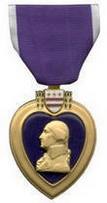
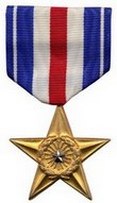
Position: Outfield
Rank: Sergeant
Military Unit: Company B, 83rd Chemical Mortar Battalion US
Army